Rita Wilkins's Blog, page 6
April 18, 2025
Minimalism Your Way: How to Make It Work for Your Personality
Hi, I’m Rita Wilkins, the Downsizing Designer, and welcome to this week’s blog!
If you’ve ever looked at a minimalist space and thought, That’s beautiful… but I could never live like that, you’re not alone. The good news? You don’t have to.
Minimalism isn’t about copying someone else’s aesthetic. It’s not about cold white walls or owning exactly 33 pieces of clothing. Minimalism is about clarity, freedom, and creating a life that aligns with your values—and it’s different for everyone.
This week, we’re talking about how to make minimalism work for your personality—whether you’re a cozy maximalist at heart or someone who thrives in bare spaces. The secret? Don’t change who you are. Instead, shape minimalism around who you already are.
 Why Personality-Driven Minimalism Works Better
Why Personality-Driven Minimalism Works Better When you try to force yourself into someone else’s version of “simple living,” it rarely lasts. But when you tailor your minimalist lifestyle to fit your strengths, habits, and preferences, it feels natural—like a better version of the life you already love.
Minimalism becomes sustainable when it becomes personal.
So let’s take a look at how different personality types can create their own version of minimalist living—and what it might look like in practice.
 The Sentimental Minimalist
The Sentimental Minimalist You love your memories and meaningful mementos, and you’re deeply connected to your family history.
What works for you:
Intentional displays of your most cherished keepsakes (instead of stuffing them in boxes) A carefully curated “legacy shelf” or photo wall Journaling or scrapbooking memories so you can let go of the physical clutterYour minimalist mantra: Keep the memory, not the mess.
 The Visual Creative Minimalist
The Visual Creative Minimalist You’re inspired by beauty, art, and color—but the chaos of clutter stifles your creativity.
What works for you:
Minimalism with pops of personality—color, texture, and creative expression Open shelving or display spaces for rotating artwork, books, or supplies Keeping your workspace clean, but your inspiration visibleYour minimalist mantra: Simplicity fuels creativity.
 The Practical Minimalist
The Practical Minimalist You’re all about functionality and efficiency. If it doesn’t serve a purpose, it’s out.
What works for you:
Thoughtfully chosen multi-use items Clean lines, easy storage, and everything in its place A streamlined home that supports your productivityYour minimalist mantra: If it’s not useful, it’s not staying.
 The Cozy Minimalist
The Cozy Minimalist You love comfort, warmth, and a home that feels like a hug.
What works for you:
Fewer, better pieces—sofa throws, books you truly love, and meaningful décor Neutral colors layered with texture to create peaceful, inviting spaces Simplified spaces that still feel lived-in and welcomingYour minimalist mantra: Comfort and calm can coexist.
 The High-Energy Minimalist
The High-Energy Minimalist You’re always on the go, juggling projects, activities, and a full calendar. You crave calm at home.
What works for you:
A clutter-free environment that serves as a sanctuary Grab-and-go systems (keys, bags, snacks, tech) to reduce daily stress Minimalist living as a way to recharge from a fast-paced worldYour minimalist mantra: Less stuff, more peace.
 How to Start Minimalism Your Way
How to Start Minimalism Your Way No matter your personality, these simple steps will help you begin a minimalist lifestyle that fits:
Define what matters to you (not what looks good on Pinterest). Declutter what doesn’t support your priorities. Create spaces that reflect your values and energy. Give yourself permission to keep what makes you feel grounded and joyful. Ignore the rules. Embrace your rhythm.Minimalism isn’t about deprivation—it’s about making room for more of what you love.
Need Help Finding Your Version of Minimalism?My Essential Checklists Workbook gives you room-by-room guidance with the flexibility to honor your unique personality and lifestyle.
✅ Tailor your decluttering to your needs
✅ Make confident decisions based on what matters to you
✅ Build a minimalist home you’ll actually enjoy
Purchase Rita’s Essential Checklists Workbook today and start designing a home that supports your version of less.
Got 5 minutes? Check out Rita’s 5 in 5 weekly series, where I share five quick tips in just five minutes on decluttering and simplifying your life.
The post Minimalism Your Way: How to Make It Work for Your Personality first appeared on Design Services LTD.April 15, 2025
🌸 “Keep, Toss, or What the Heck Is This?” 7-Day Spring Cleaning Challenge
You know it’s spring when the flowers bloom, the sun shines a little brighter—and that mystery closet suddenly starts mocking you every time you walk by.
It’s time to take action. Fun action. Decluttering action.
Welcome to my “Keep, Toss, or What the Heck Is This?” 7-Day Spring Cleaning Challenge—the weekly reset your home didn’t know it needed (but you definitely did).
We’re not going for Pinterest-perfect. We’re going for progress. Clarity. Peace of mind. And maybe even a few good laughs along the way.
🌟 How Does this 7-Day Spring Challenge Works
Each day, for 7 days straight, you’ll tackle one small space, one decision at a time, using my favorite three-question method:
Keep – I love it, I use it, I need it. It earns its space.Toss – It’s broken, outdated, or brings zero joy. Bye-bye!What the Heck Is This? – If you can’t name it, you can’t claim it. Out it goes.And the best part? You can repeat this 7-day challenge as many times as you like—once a month, once a season, or every time your drawer overflows.
🧼 Your 7-Day Decluttering Adventure
DAY 1: The “One Drawer Wonder”Pick any drawer in your home—kitchen, bathroom, nightstand, or the junk drawer (especially the junk drawer).
Mini Challenge: Find 3 items you’ve had for over a year that you haven’t used. Toss or donate them today.
DAY 2: The Closet CountdownOpen your closet. Choose 7 items of clothing. Hold each one and ask: “Do I love this? Does it fit? Would I buy it again?”
Mini Challenge: Remove 2 items you’re holding onto “just in case.”
DAY 3: Bathroom BottleneckScan your cabinets and shelves for old products, expired meds, or hotel samples you swore you’d use.
Mini Challenge: Clear out 5 items and create one clean, calm shelf of “only what I use.”
DAY 4: Kitchen Clear-OutOpen a cabinet or pantry. Focus on utensils, Tupperware lids with no bottoms, and spices from another decade.
Mini Challenge: Toss or donate 10 items that have overstayed their welcome.
DAY 5: Paper Pile PatrolTackle that pile of mail, receipts, or files lurking in plain sight.
Mini Challenge: Recycle 10 pieces of paper and organize what’s left into 2 neat categories: Action + Archive.
DAY 6: Sentimental SaturdayChoose 3 sentimental items—old cards, your kid’s preschool art, grandma’s dish collection.
Mini Challenge: Let go of one item by honoring its memory with a photo or short journal entry.
DAY 7: Celebration + ResetLook back at what you’ve accomplished. Feel the difference in your space and spirit.
Mini Challenge: Write down one area you’ll tackle next week. Then reward yourself—a walk, a bath, or 10 guilt-free minutes with your favorite book.
✨ Why Rita’s Spring Challenge WorksYou don’t have to do it all at once. You just have to start.
And when you repeat this 7-day challenge weekly, even for just one month, you’ll be amazed at how much lighter, freer, and more energized you feel.
Because less clutter = more you.
🔄 Ready to Repeat?
Bookmark this blog and return to it every week for a fresh roundMake it a household game—get the whole family involved!Want to go deeper? Grab my Minimalist Essentials Workbook in the online shop—decluttering checklists, tips, and tools to make the process effortlessRemember:
“You don’t have to keep what no longer fits your home, your life, or your future.”
Let this be the spring you choose freedom. One drawer, one day, one “what the heck is this?” at a time.
Are you in?
SHARE YOUR STORY!Sign up for Rita’s FREE Newsletter HERE!Never miss an episode! Click the following link to like Rita’s Facebook page or subscribe to her Decluttering YouTube Channel. Check out our YouTube playlists if you want to learn more.
Follow me on social media for more updates:YOUTUBE | FACEBOOK | INSTAGRAM | LINKEDIN | TWITTERThe post 🌸 “Keep, Toss, or What the Heck Is This?” 7-Day Spring Cleaning Challenge first appeared on Design Services LTD.April 11, 2025
How to Declutter Based on Your Personality (Not Just a Checklist)
Hi, I’m Rita Wilkins, the Downsizing Designer, and welcome to this week’s blog!
If you’ve ever looked around your home and wondered, Why do I have so many of the same thing? or Why do I collect but never use?—you’re not alone. Clutter doesn’t just show up randomly; it’s often a reflection of your personality, mindset, and habits.
That’s why one-size-fits-all checklists often fall flat. They don’t address the why behind your clutter—so the problem keeps coming back. Today, we’re digging into five common types of clutter, the personality traits behind them, and tailored strategies to help you declutter effectively and compassionately.
 1. Aspirational Clutter
1. Aspirational Clutter You own tons of supplies for a hobby or lifestyle you’re not actually living.
What it looks like:
✔ Art supplies still in packaging
✔ Fitness gear you haven’t used in months
✔ Books about a career path or topic you’ve moved on from
The personality behind it:
You’re a dreamer—curious, passionate, and optimistic. You love to learn, grow, and imagine new versions of yourself. But you may also struggle with follow-through or feel guilt about not becoming that idealized version.
Decluttering strategy:
Identify which hobbies or goals you’re truly excited about now. Give yourself permission to release what no longer aligns with your life. Donate supplies to schools, libraries, or community centers where they’ll be used. Keep one small box labeled “Maybe Someday” and revisit it in 6 months. 2. Redundancy Clutter
2. Redundancy Clutter You have multiples of items that serve the same purpose—just in case.
What it looks like:
✔ Six spatulas or can openers
✔ Drawers full of batteries, cords, and pens
✔ Closet full of black sweaters or jeans in nearly identical styles
The personality behind it:
You’re a security-seeker—practical, prepared, and resourceful. You like being ready for anything, but this mindset can lead to over-collecting and fear-based decision-making.
Decluttering strategy:
Ask: What’s the best version of this item? Keep that one. Set physical limits (e.g., one drawer for cords, one shelf for tools). Practice trusting that you can replace or borrow something if needed. Donate functional extras to shelters or donation centers. 3. Information Clutter
3. Information Clutter You’re buried in paper, notes, receipts, and magazines—but feel paralyzed throwing them away.
What it looks like:
✔ Piles of unread magazines or clipped articles
✔ Notebooks filled with ideas, goals, or reminders
✔ Receipts, coupons, and instruction manuals “just in case”
The personality behind it:
You’re a thinker—curious, detail-oriented, and analytical. You love collecting knowledge, but the fear of forgetting or missing something important can lead to overwhelm.
Decluttering strategy:
Digitize what you can: scan documents and organize them in cloud storage. Create a rotating “Read This Month” basket—and let go of anything that ages out. Toss manuals you can find online and shred outdated paperwork. Set a weekly “paper purge” appointment. 4. Sentimental Clutter
4. Sentimental Clutter You struggle to let go of things with emotional or nostalgic meaning.
What it looks like:
✔ Baby clothes from grown-up children
✔ Gifts you feel guilty donating
✔ Old birthday cards, letters, and souvenirs
The personality behind it:
You’re a feeler—compassionate, relational, and deeply connected to people and memories. Letting go can feel like betraying your past or someone you love.
Decluttering strategy:
Keep one meaningful item per person, per milestone (not a whole box). Take photos of items you want to remember but don’t need to store. Remind yourself: the memory lives in your heart, not the object. Create a small “Legacy Box” and be intentional about what earns a place in it. 5. Convenience Clutter
5. Convenience Clutter Your stuff tends to pile up because you don’t have systems in place—or the time to deal with it.
What it looks like:
✔ Unopened mail or online orders sitting by the door
✔ Piles on kitchen counters, desks, or floors
✔ Clothing on “the chair” instead of in the closet
The personality behind it:
You’re a doer—busy, multitasking, and often focused on others. You tend to prioritize action and productivity over tidiness, but the clutter builds up when there’s no clear system to fall back on.
Decluttering strategy:
Create “drop zones” for keys, mail, and bags—make them attractive and obvious. Do a 5-minute nightly reset to reset common areas. Batch tasks like mail sorting or laundry folding to reduce mental load. Don’t aim for perfect—aim for functional. The Big Takeaway: Match the Method to the Mindset
The Big Takeaway: Match the Method to the Mindset There is no one right way to declutter—only the one that fits your personality, habits, and goals.
When you understand the clutter you accumulate, you can finally release it with clarity and kindness. Whether you’re a dreamer, a security-seeker, or a sentimentalist, you have the power to create a home that reflects who you are—and who you’re becoming.
 Ready for a Decluttering Plan That Respects Your Style?
Ready for a Decluttering Plan That Respects Your Style? My Essential Checklists Workbook isn’t about rules—it’s about creating a decluttering process that works with how you live.
✅ Customize your decluttering based on clutter type
✅ Get organized without losing your personality
✅ Make decisions with confidence and ease
Purchase Rita’s Essential Checklists Workbook today and begin simplifying on your terms.
Got 5 minutes? Check out Rita’s 5 in 5 weekly series, where I share five quick tips in just five minutes on decluttering and simplifying your life.
 The post How to Declutter Based on Your Personality (Not Just a Checklist) first appeared on Design Services LTD.
The post How to Declutter Based on Your Personality (Not Just a Checklist) first appeared on Design Services LTD.
April 8, 2025
The Hidden Cost of “Someday Clutter”: Why It’s Important to Address It
“Someday clutter.” “What if” clutter. We all have it.
It’s the stuff we hold onto because we might need it or want it someday.
It’s the stuff we’re afraid to let go of because we fear we might regret it.
Sound familiar?
Jeans we hope to fit into someday.Books we plan to read.Old receipts we think we might need.Craft supplies we’d like to use when we have time.At first glance, it may not seem like clutter at all. But take a look around your home—you’ll quickly realize just how much “someday clutter” you’re holding onto.
It’s overwhelming.
And it’s everywhere—in closets, cabinets, and drawers. Our attics, basements, and garages are filled with “someday clutter”:
Items we rarely use.Things that are broken, in need of repair, or outdated.Heirlooms we’re saving for our kids or grandkids—even though they may not want them.The Real Cost of Someday ClutterSomeday, clutter doesn’t just take up space—it takes up mental space too. Each item you hold onto demands something from you:
Space – It makes your home feel cluttered and cramped.Time – You waste time organizing, cleaning, and maintaining it.Energy – It drains your focus and productivity.But the hidden emotional costs are even greater:
Stress and anxiety from too much clutter.Guilt and shame for accumulating so much stuff.Frustration and aggravation from constantly searching for things.So why is it so hard to let go?
Because every item carries an emotional weight.
That unworn dress in your closet?
“I’ll wear it again when I lose 10 pounds.”“I used to wear that when I was an executive.”“I still feel guilty about spending so much money on that jacket.”Why Letting Go MattersSomeday clutter is a burden—it keeps you focused on imagined scenarios rather than your life right now.
“What if I need that old appliance manual even though I replaced it?”“What if I need that broken lamp? I can fix it… someday.”But the reality is that clutter prevents you from living in the present. It controls your space, your time, and your energy.
The Benefits of Letting GoImagine finally decluttering your someday clutter.
You wouldn’t just be clearing out physical space—you’d be releasing the emotional weight that’s been holding you back.
You’d be making room for:
✅ New experiences
✅ A calmer, more peaceful home
✅ Less stress and more freedom
1️⃣ Reframe the conversation with yourself.
Instead of asking, “What if I need this someday?” ask:“What is this costing me in space, time, and peace of mind?”“Am I holding onto this out of habit or fear?”2️⃣ Commit to letting go.
Schedule a decluttering session.Take it one item at a time.Be tough on yourself—it’s worth it!3️⃣ Don’t second-guess yourself.
Decide ahead of time where you’ll donate or sell the items.Stick to your decisions—no backtracking!4️⃣ Use this list to motivate yourself.
Common “Someday Clutter” Items to Let Go Of:Clothes you haven’t worn in years.Books, magazines, and papers you planned to read but never did.Unused or broken household items.Outdated/damaged tools and electronics (wires, chargers, etc.).Multiple kitchenware items (mugs, dishes, water bottles).Junk mail, old receipts, and outdated documents.Plastic food containers with mismatched lids.Outdated home décor.Expired toiletries.Toys your kids have outgrown.Craft supplies you haven’t touched in years.Family heirlooms you don’t want—and your kids don’t want either.Bargain items you never used.Broken items you intended to fix but never did.These are just some of the things we convince ourselves we might need someday.
The Bottom LineThe truth is, someday rarely comes.
By letting go of clutter today, you’re making space for a lighter, freer, and more peaceful life.
Why wait? Start decluttering now—your future self will thank you.
SHARE YOUR STORY!Sign up for Rita’s FREE Newsletter HERE!Never miss an episode! Click the following link to like Rita’s Facebook page or subscribe to her Decluttering YouTube Channel. Check out our YouTube playlists if you want to learn more.
Follow me on social media for more updates:YOUTUBE | FACEBOOK | INSTAGRAM | LINKEDIN | TWITTERThe post The Hidden Cost of “Someday Clutter”: Why It’s Important to Address It first appeared on Design Services LTD.April 4, 2025
Understanding Your Clutter Personality: The First Step to Letting Go
Hi, I’m Rita Wilkins, the Downsizing Designer, and welcome to this week’s blog!
If you’ve ever asked yourself, “Why is it so hard for me to declutter?” or “Why do other people seem to have no problem letting go of things?”—you’re not alone. The truth is, there’s no one-size-fits-all approach to decluttering, and the key to lasting success often starts with a deeper understanding of you.
In this blog, we’re going to explore what I call your “Clutter Personality”—the way your habits, emotions, and beliefs influence how you hold onto things. Once you understand your unique clutter type, you’ll be better equipped to find strategies that actually work for you—not just another checklist that ends up collecting dust.
 Why Self-Awareness Matters in Decluttering
Why Self-Awareness Matters in Decluttering So many people struggle with clutter not because they’re disorganized, but because they’ve never taken the time to ask:
What’s behind my clutter? What am I afraid of letting go of? What does my stuff say about how I see myself?Understanding your clutter personality helps you uncover the emotional roots of your clutter—and once you see them clearly, you can finally take steps to release them.
 The 5 Most Common Clutter Personalities
The 5 Most Common Clutter Personalities Over the years, I’ve worked with thousands of people trying to simplify their homes and lives. While everyone’s story is unique, most fall into one (or more) of these clutter personalities:
1. The Sentimental Keeper
You keep things because they remind you of a special memory or person.
✔ Struggle: Letting go feels like erasing the past.
✔ Solution: Choose a few meaningful items to keep or display. Take photos of the rest to preserve the memory without the physical clutter.

2. The Bargain Hoarder
You love a good deal and keep items “just in case” because they were free or inexpensive.
✔ Struggle: You feel wasteful if you throw something away.
✔ Solution: Remind yourself that true value lies in use, not in price. Donate duplicates and let your extra blessings serve others.

3. The Aspirational Minimalist
You keep things that reflect who you want to be—craft supplies, workout gear, clothes for a future version of yourself.
✔ Struggle: Letting go feels like giving up on your goals.
✔ Solution: Focus on the version of you who exists now. Donate items that no longer align with your current life and make space for what you’re truly passionate about today.

4. The Overwhelmed Avoider
You’re too busy, too tired, or too overwhelmed to even start. So things pile up, and you feel stuck.
✔ Struggle: Decluttering feels exhausting before it even begins.
✔ Solution: Start small. One drawer, one shelf, or five items a day. Use a timer and give yourself grace. Progress, not perfection.

5. The Security Keeper
You keep extras of everything because they give you a sense of control or comfort.
✔ Struggle: Letting go feels unsafe or irresponsible.
✔ Solution: Set limits. Keep the best, let go of the rest. Remind yourself that you’ll be okay—and even freer—without all the backups.
 How to Identify Your Clutter Personality
How to Identify Your Clutter Personality Not sure which one you are? You might be a mix! Ask yourself:
Which type do I emotionally relate to most? What’s the most common reason I avoid letting go of things? When I try to declutter, where do I get stuck?When you know your clutter personality, you stop blaming yourself—and start building systems that actually support the way you operate.
 The First Step to Letting Go
The First Step to Letting Go Awareness leads to compassion. Instead of feeling guilty about your clutter, get curious about it. What is it really telling you? What might you be ready to release—physically, mentally, and emotionally?
The more you understand your clutter personality, the easier it is to create a personalized, compassionate path toward letting go.
 Need a Companion Tool to Help You Begin?
Need a Companion Tool to Help You Begin? If you want help recognizing your habits and making real progress, my Emotional Clutter Workbook is a great starting point. It walks you through the five emotional clutter types and offers simple, healing exercises to help you move forward.
Purchase Rita’s Emotional Clutter Workbook today and begin your journey to a lighter, freer life.
Got 5 minutes? Check out Rita’s 5 in 5 weekly series, where I share five quick tips in just five minutes on decluttering and simplifying your life.
 The post Understanding Your Clutter Personality: The First Step to Letting Go first appeared on Design Services LTD.
The post Understanding Your Clutter Personality: The First Step to Letting Go first appeared on Design Services LTD.
April 1, 2025
Declutter Like a Minimalist: Must-Have Organization Solutions That Actually Work
I don’t often talk about organizational products, but when I do, you know it’s because I’ve tested it, loved it, and found it essential to maintaining a clutter-free, minimalist lifestyle.
Decluttering isn’t just about getting rid of things—it’s about creating a home that works for you, not against you. If you’re tired of constantly shifting piles of stuff from one place to another, it’s time to get serious about organization.
But before we dive into the best organizational tools, let’s talk about something equally important: travel. Minimalism isn’t just about how you live at home—it’s also about how you move through the world. Packing light and choosing quality essentials can make travel stress-free and more enjoyable.
Below, I’ve curated a selection of my favorite organizational must-haves. From travel essentials that make packing stress-free to home organization tools that will transform cluttered spaces, these are the game-changers that can help you live a more organized, minimalist life.
Travel Must-Haves for the Minimalist on the Go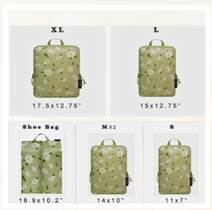 Ultralight Compression Packing Cubes
Ultralight Compression Packing CubesSay goodbye to overstuffed suitcases! These compression cubes maximize space and keep your clothes neatly separated. No more rummaging through messy piles while traveling.
Minimalist Tip: If your suitcase fights back when you zip it up, you’ve packed too much!
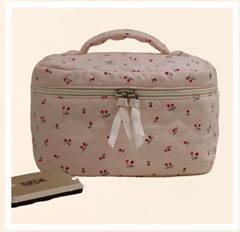 Large Travel Makeup Bag
Large Travel Makeup BagA spacious yet compact organizer for all your beauty essentials. Whether you’re a minimalist with skincare or a beauty enthusiast, this keeps everything in order.
Minimalist Tip: If your makeup bag is bursting at the seams, it’s time to simplify your routine!
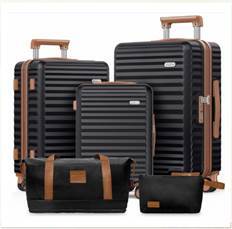 5-Piece Luggage Set
5-Piece Luggage SetA hard-shell suitcase set with a matching carry-on, weekender duffel, and toiletry bag—everything you need for stress-free travel without unnecessary clutter.
Minimalist Tip: The less you pack, the less you have to lug around!
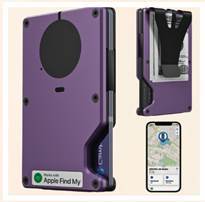 AirTag Wallet
AirTag WalletNever lose your wallet again. This sleek design holds your essentials while offering tracking for peace of mind.
Minimalist Tip: If you’re carrying more receipts than cash, declutter your wallet!
Now, let’s get back to decluttering your home.Here are 9 hand-picked, game-changing organization tools that will help you reclaim your space and simplify your life.
Plus, at the end, I’m sharing 4 must-have books/workbooks that will transform how you approach decluttering and home organization!
Game-Changing Home Organization Tools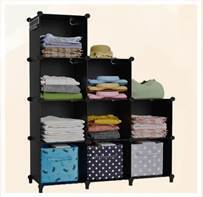 9-Cube Closet Organizer
9-Cube Closet OrganizerFlexible, modular, and perfect for organizing clothes, shoes, or accessories. Whether in your closet or entryway, this is a minimalist’s dream storage solution.
Minimalist Tip: If your clothes don’t fit in this, you have too many!
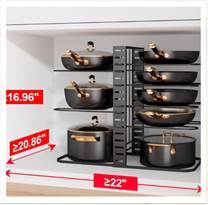 Pots and Pans Organizer
Pots and Pans OrganizerTired of chaotic kitchen cabinets? This organizer neatly stacks cookware, making meal prep smoother.
Minimalist Tip: If you have more pots than burners, it’s time to downsize!
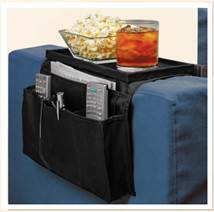 Sofa Armrest Organizer
Sofa Armrest OrganizerNo more searching for lost remotes or reading glasses. This keeps essentials within arm’s reach and your coffee table clutter-free.
Minimalist Tip: If you need a whole drawer for remotes, you have too many!
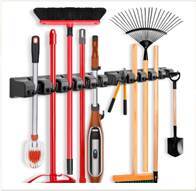 Mop and Broom Holder
Mop and Broom HolderWall-mounted and space-saving, this keeps your cleaning tools organized instead of piling up in a corner.
Minimalist Tip: If you never use a cleaning tool, why keep it?
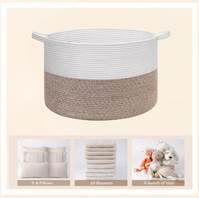 Large Cotton Rope Basket
Large Cotton Rope BasketStylish yet practical, this is perfect for blankets, toys, or laundry while maintaining a clean aesthetic.
Minimalist Tip: A clutter-free home isn’t empty—it’s intentional.
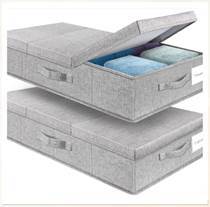 Underbed Storage Containers
Underbed Storage ContainersIdeal for seasonal clothing or spare linens, these maximize unused space under your bed.
Minimalist Tip: Don’t just store—declutter first!
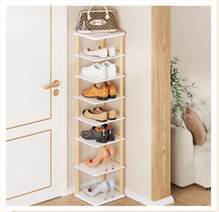 8-Tier Vertical Shoe Rack
8-Tier Vertical Shoe RackIf your shoes are piling up, this sleek organizer keeps them tidy while saving floor space.
Minimalist Tip: If you haven’t worn them in a year, it’s time to let go!
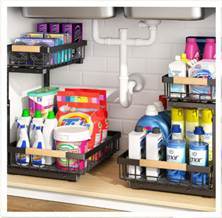 Double Sliding Under Sink Organizer
Double Sliding Under Sink OrganizerSay goodbye to the under-sink abyss. This system ensures that cleaning supplies are accessible and not forgotten.
Minimalist Tip: Organizing is great, but decluttering comes first!
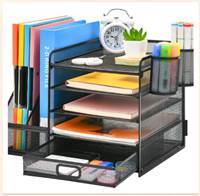 Desk File Organizer
Desk File OrganizerKeep paperwork, files, and even your laptop neatly arranged for a clutter-free workspace.
Minimalist Tip: If a document is expired or untouched for a year, let it go!
Books/Workbooks to Inspire Your Decluttering JourneyIf you’re ready to go beyond organizing and truly embrace a minimalist lifestyle, these books will transform the way you think about clutter and consumption:
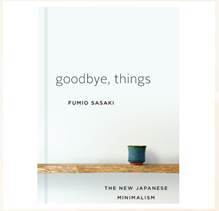 Goodbye, Things by Fumio Sasaki
– A deeply personal look at the power of owning less and how minimalism can lead to a more fulfilling life.
Goodbye, Things by Fumio Sasaki
– A deeply personal look at the power of owning less and how minimalism can lead to a more fulfilling life.
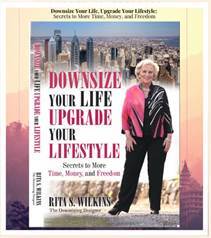 Downsize Your Life, Upgrade Your Lifestyle by Rita Wilkins
– My bestselling book that guides you through downsizing and intentional living to create a life that truly aligns with what matters most.
Downsize Your Life, Upgrade Your Lifestyle by Rita Wilkins
– My bestselling book that guides you through downsizing and intentional living to create a life that truly aligns with what matters most.
 A Journey to Less: A Life Designed for More (New eBook by Rita Wilkins)
– This isn’t just about decluttering—it’s about designing a life you love with less stress and more freedom.
A Journey to Less: A Life Designed for More (New eBook by Rita Wilkins)
– This isn’t just about decluttering—it’s about designing a life you love with less stress and more freedom.
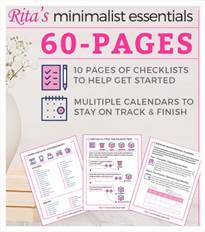 Minimalist Essential Workbook by Rita Wilkins
– A practical step-by-step guide designed to help you declutter with confidence, build sustainable habits, and simplify every area of your home.Final Thoughts
Minimalist Essential Workbook by Rita Wilkins
– A practical step-by-step guide designed to help you declutter with confidence, build sustainable habits, and simplify every area of your home.Final ThoughtsDecluttering is more than just tidying up—it’s about designing a life that aligns with your values and priorities. With these minimalist-approved organization solutions, you can create a home that feels lighter, more functional, and truly intentional.
Which of these must-haves will you be adding to your space? Let me know in the comments, and don’t forget to check out my full collection of decluttering workbooks and guides for even more minimalist inspiration!
Some of the links in this post are affiliate links, meaning I may earn a small commission if you make a purchase—at no extra cost to you. This helps support my work in bringing you the best minimalist resources. Thank you for your support!
Visit my online shop to explore Rita’s Minimalist Essentials Collection and start your journey toward a clutter-free life today: https://www.designservicesltd.com/store/
Live simply. Live intentionally!The post Declutter Like a Minimalist: Must-Have Organization Solutions That Actually Work first appeared on Design Services LTD.March 28, 2025
Spring Decluttering Wrap-Up: The Mindset Shift That Makes It Last
Hi, I’m Rita Wilkins, the Downsizing Designer, and welcome to this week’s blog!
Spring decluttering is more than just an annual clean-out—it’s an opportunity to reset your home, your habits, and your mindset. But what happens after the initial burst of motivation wears off? How do you make your decluttered home stay that way?
The secret isn’t in the perfect organizing system or a one-time purge—it’s in your mindset. Today, we’re going to talk about the key shift that turns decluttering from a seasonal event into a lasting lifestyle.
 Decluttering Isn’t Just an Activity—It’s a Mindset
Decluttering Isn’t Just an Activity—It’s a Mindset Most people approach decluttering as a one-and-done project. You spend a weekend (or a whole month) clearing out the clutter, feeling accomplished when it’s over.
But then… the clutter starts creeping back. The junk drawer fills up again, the closet overflows, and before you know it, you’re back where you started.
That’s because decluttering isn’t just about getting rid of stuff—it’s about changing the way you think about what you bring into your life.
 The Mindset Shift That Makes Decluttering Stick
The Mindset Shift That Makes Decluttering Stick To maintain a clutter-free space, you have to go from:
✔ Decluttering as an event → To decluttering as a habit
✔ Organizing your space → To curating your life
✔ Letting go of excess → To being intentional about what comes in
It’s about choosing what deserves a place in your home and life—every single day.
 How to Make Spring Decluttering Last: 5 Key Habits
How to Make Spring Decluttering Last: 5 Key Habits If you want your spring decluttering to stick, start incorporating these five simple habits into your daily routine.
1. Adopt a “One In, One Out” Rule
If something new comes in, something old must go out.
✔ Bought a new shirt? Donate an old one.
✔ Got a new kitchen gadget? Let go of one you never use.
This keeps clutter from creeping back in—without needing another big purge.

2. Set Clutter Boundaries
Instead of waiting for clutter to take over, set limits before it happens.
✔ Keep books only on a designated shelf—if they don’t fit, it’s time to donate.
✔ Limit sentimental keepsakes to one memory box per person.
✔ Designate a single junk drawer (and clean it out once a month).
Boundaries make it easier to maintain a clutter-free home without constant effort.

3. Create a Daily Reset Habit
Take 5 minutes at the end of each day to reset your space.
✔ Clear off kitchen counters.
✔ Tidy up the entryway.
✔ Put clothes and shoes back where they belong.
This prevents small messes from turning into big clutter piles.

4. Shift Your Mindset on Stuff
Instead of asking what to get rid of, start asking:
✔ Does this item add value to my life?
✔ Do I truly love and use this?
✔ Would I buy this again today?
The more intentional you are about what stays, the less you have to declutter in the future.

5. Check In with Yourself Regularly
Minimalism and decluttering aren’t about perfection—they’re about progress.
✔ Do a seasonal clutter check (before summer, fall, and winter).
✔ If you notice areas getting messy again, don’t judge yourself—just reset.
✔ Celebrate the progress you’ve made!
Decluttering is a lifetime habit, not a one-time event.
 A Clutter-Free Home = A Clutter-Free Mind
A Clutter-Free Home = A Clutter-Free Mind When your home is clear, your mind feels clearer, too. You’ll find yourself:
✨ Spending less time cleaning
✨ Enjoying more mental space
✨ Feeling lighter and more in control of your environment
Spring decluttering is just the beginning—the real transformation happens when you commit to a minimalist mindset all year long.
So as you wrap up your spring decluttering, don’t just celebrate a cleaner home—celebrate a new way of living.
 Need a Simple Way to Stay on Track?
Need a Simple Way to Stay on Track? If you want to keep your decluttering momentum going, my Essential Checklists Workbook makes it easy.
✅ Room-by-room checklists so you never feel overwhelmed
✅ Step-by-step decluttering guides to simplify every space
✅ A sustainable system to help you stay clutter-free year-round
Purchase Rita’s Essential Checklists Workbook today and create a home that stays clear, calm, and clutter-free.
Got 5 minutes? Check out Rita’s 5 in 5 weekly series, where I share five quick tips in just five minutes on decluttering and simplifying your life.
 The post Spring Decluttering Wrap-Up: The Mindset Shift That Makes It Last first appeared on Design Services LTD.
The post Spring Decluttering Wrap-Up: The Mindset Shift That Makes It Last first appeared on Design Services LTD.
March 26, 2025
Decluttering Your Mind: The Key to a More Focused Life
By Rita Wilkins
We’re constantly being told to declutter our homes, our closets, and our digital lives… but what about decluttering our minds?
Mental decluttering is just as important – if not more – because it forms the foundation upon which we build our entire lives. When our minds are cluttered, we feel stuck; unable to focus, think clearly, or make progress toward our goals.
But when we declutter our minds, we free up mental space to focus, be more productive, and live a happier, more fulfilling life.
The Struggle with Mental ClutterStress, anxiety, and overwhelm are just a few of the challenges we face when our minds are overloaded.
If you’re tired of the constant mental chatter, you’re not alone.
In this blog, I’ll share practical strategies to help you break free from the cycle of:
Feeling stuck, overwhelmed, and paralyzed by indecision.Having a never-ending to-do list that makes you feel unproductive and like a failure.Struggling to focus, feeling distracted, and unable to complete even the smallest daily tasks.But here’s the good news:
With the right strategies, you can learn how to:
Quiet the noise in your head.Let go of what’s preventing you from achieving your goals.Live a freer, happier, and more fulfilled life.Signs You’re Struggling with Mental ClutterConstantly starting new tasks without finishing old ones.Excessive worrying.Overthinking and overanalyzing.Ongoing negative self-talk.Difficulty focusing and getting easily distracted.A racing mind that jumps from one thought to the next.Feeling stuck or in a rut.What Causes Mental Clutter?Indecisiveness and failure to make decisions.Information overload.Unrealistic expectations and deadlines.An overpacked to-do list.Unresolved emotions or issues.Lack of productivity.The Impact of Mental ClutterDecreases productivity.Hinders focus.Drains energy and motivation.Disrupts sleep and self-care.Promotes forgetfulness.Increases stress, anxiety, and overwhelm.Strategies to Declutter Your Mind and Live Freely1. Take Time to ReflectSit quietly and reflect on your thoughts and emotions. Identify areas where you feel stuck and where you want to make progress. Prioritize what matters most and create a vision for the life you want.
2. Dump Your ThoughtsUse a journal to write down the thoughts and emotions that are draining you. Acknowledge what’s holding you back.
A few examples:
“I’m frustrated because I can’t focus and get anything done.”“I’m overwhelmed because my to-do list never ends.”“I feel guilty and stressed about my messy house.”“I missed an important deadline at work due to disorganization.”“I’m constantly worried about money.”“I feel unfulfilled and stuck in a job I dislike.”3. Notice Common ThemesMost mental clutter revolves around work, relationships, money, and productivity.
For example:
“I get stressed when I don’t feel productive.”“I get overwhelmed when my to-do list is too long.”“I feel anxious when I think about my ex.”“I struggle to sleep when I’m worried.”“I beat myself up when I don’t reach my goals.”4. Recognize Unhelpful Habits“When I’m stressed, I eat junk food.”“When I’m distracted, I waste time on social media.”“When I’m overwhelmed, I avoid making decisions.”“When I’m unproductive, I spiral into negative self-talk.”Taking Control of Your Thoughts and ActionsWhat’s one thing you can do to feel more in control?
Make decisions and take action.Clutter is a series of postponed decisions. Stop postponing.Shift your mindset.Focus on solutions, not problems.Let go of what’s holding you back.Decide what no longer serves you and release it.Set realistic expectations and timelines.Small steps still count as progress.Limit your to-do list.You can always add more later.Face unresolved emotions.Don’t let them fester – address them head-on.Let go of things you can’t control.Make peace with what’s beyond your influence.Maintaining a Clutter-Free MindMental clutter will always creep back in – but having strategies in place will help you clear it quickly and get back on track.
1. Keep a JournalJournaling helps you track your thoughts and emotions. Notice recurring themes, habits, and patterns, and learn to separate the noise from what truly matters.
2. Practice MindfulnessFocus on the present moment and what’s most important to you. Prioritize one thing at a time.
Mindfulness strategies include:Self-care: Exercise, eat well, and get enough sleep.Time outdoors: Get fresh air and sunshine.Daily joy: Do something that makes you laugh.Center yourself: Clarify what truly matters to you.Revisit your goals: Adjust and re-prioritize as needed.Set boundaries: Learn to say no and honor your needs.Delegate: Ask for support when necessary.Create a new vision: Make space for what’s possible.Be kind to yourself: Practice self-compassion.Let go of perfection: Focus on intention, not flawlessness.The Freedom of a Decluttered MindWhen you take back control of your thoughts, you open yourself up to a life of clarity, peace, and fulfillment.
Decluttering your mind lifts the weight of mental overload, allowing you to:
See clearly – distinguish what truly matters from mere distractions.Focus on joy and purpose – prioritize what brings you fulfillment.Feel lighter and happier – live the life you deserve.Bottom LineWhen your mind is cluttered, it can feel like you have a hundred browser tabs open – and you can never quite shut them down.
Whatever it may be, mental clutter is real, and it holds us back from living our best lives.
It’s easy to get caught up in the flood of thoughts, emotions, and responsibilities we face every day.
Clearing mental clutter isn’t just about eliminating negative thoughts – it’s about making space for what matters most.
SHARE YOUR STORY!Sign up for Rita’s FREE Newsletter HERE!Never miss an episode! Click the following link to like Rita’s Facebook page or subscribe to her Decluttering YouTube Channel. Check out our YouTube playlists if you want to learn more.
Follow me on social media for more updates:YOUTUBE | FACEBOOK | INSTAGRAM | LINKEDIN | TWITTERThe post Decluttering Your Mind: The Key to a More Focused Life first appeared on Design Services LTD.March 21, 2025
The Psychology of Clutter: Why We Hold On and How to Move Forward
Hi, I’m Rita Wilkins, the Downsizing Designer, and welcome to this week’s blog! If you’ve ever struggled to let go of things—despite knowing they no longer serve you—you’re not alone.
Decluttering isn’t just about getting rid of stuff. It’s about understanding why we hold onto things in the first place. Behind every piece of clutter, there’s often an emotional attachment, a hidden fear, or a belief that keeps us stuck.
So today, we’re diving into the psychology of clutter—why we struggle to let go and how we can break free to create a home and life that truly support us.
 Why Do We Hold Onto Clutter? 1. Sentimental Attachments
Why Do We Hold Onto Clutter? 1. Sentimental Attachments Many of us attach memories to objects, making it difficult to let go. Whether it’s an old letter, a childhood toy, or a gift from a loved one, we fear that if we discard the item, we’ll lose the memory associated with it.
But here’s the truth: Memories live in us, not in our stuff.
👉 Try this: Instead of keeping everything, select a few meaningful pieces and consider taking photos of the rest. A digital memory can be just as powerful—without taking up space.
 2. Fear of Regret (“What If I Need This Someday?”)
2. Fear of Regret (“What If I Need This Someday?”) We often keep things “just in case” because we fear making the wrong decision. What if I need this later? What if I throw it out and regret it?
But holding onto clutter for hypothetical situations creates real stress in our present lives.
👉 Try this: Use the 20/20 Rule—If you can replace an item for less than $20 in under 20 minutes, let it go. This mindset shift can make decluttering feel much easier.
 3. The “Sunk Cost” Fallacy
3. The “Sunk Cost” Fallacy Have you ever kept something just because you spent money on it? Maybe it’s expensive shoes that hurt your feet, a kitchen gadget you never use, or a jacket that still has tags on it.
The problem? The money is already spent—whether you keep the item or not. But by letting it go, you free up space and energy for what truly serves you.
👉 Try this: Instead of thinking about the money you lost, focus on what you gain—peace of mind, more space, and the ability to make better purchasing choices moving forward.
 4. Identity Clutter: Holding Onto Past Versions of Ourselves
4. Identity Clutter: Holding Onto Past Versions of Ourselves Many of us keep things that represent who we used to be—clothes from a job we left, hobbies we no longer pursue, or books we meant to read but never did.
But holding onto these items can keep us stuck in the past, making it harder to fully embrace who we are today.
👉 Try this: Ask yourself, Does this item reflect the life I’m living now—or the life I’ve already outgrown? If it no longer aligns with your current self, it’s okay to let it go.
 How to Move Forward: 5 Steps to Letting Go
How to Move Forward: 5 Steps to Letting Go If you’re ready to release the emotional weight of clutter, here’s how to move forward with confidence:
1. Start Small & Build MomentumDecluttering doesn’t have to be overwhelming. Begin with one drawer, one shelf, or one small area. Seeing progress—no matter how small—makes it easier to keep going.
 2. Shift Your Perspective
2. Shift Your Perspective Instead of focusing on what you’re losing, think about what you’re gaining—less stress, more time, and a peaceful home.
 3. Give Items a Second Life
3. Give Items a Second Life It’s easier to let go when you know your items will be used and loved by someone else. Donate clothing, books, or household items to shelters, charities, or friends in need.
 4. Set a Decluttering Deadline
4. Set a Decluttering Deadline Create a “Maybe Box”—place uncertain items inside and set a reminder for 30 days. If you haven’t needed or missed them by then, you’ll feel more confident letting them go.
 5. Seek Support & Accountability
5. Seek Support & Accountability Decluttering is emotional, and it’s okay to ask for help. Enlist a friend, family member, or professional organizer to keep you motivated and on track.
 Letting Go Frees You to Move Forward
Letting Go Frees You to Move Forward Clutter isn’t just physical—it’s emotional, too. By understanding why we hold onto things, we can break free from the mental weight of clutter and create space for what truly matters.
Every item you let go of makes room for peace, clarity, and a life aligned with your values. So take that first step today—you deserve a home that supports you, not one that holds you back.
 Need Help Letting Go of Emotional Clutter?
Need Help Letting Go of Emotional Clutter? If you struggle with sentimental items, identity clutter, or the fear of letting go, my Emotional Clutter Workbook is designed to guide you through the process.
✅ Recognize the emotions behind clutter
✅ Learn how to release items with confidence
✅ Create a home that truly supports your well-being
Purchase Rita’s Emotional Clutter Workbook today and take the first step toward decluttering with peace and purpose.
Got 5 minutes? Check out Rita’s 5 in 5 weekly series, where I share five quick tips in just five minutes on decluttering and simplifying your life.
 The post The Psychology of Clutter: Why We Hold On and How to Move Forward first appeared on Design Services LTD.
The post The Psychology of Clutter: Why We Hold On and How to Move Forward first appeared on Design Services LTD.
March 18, 2025
Understanding Your Cluttering Habits—So You Can Fix Them
What if I told you that the biggest obstacle between you and a clutter-free home isn’t the clutter itself—it’s your cluttering habits?
Today, I want to share one of the most important lessons I learned on my own decluttering journey, so you don’t have to make the same mistakes I did.
Like many of you, I felt overwhelmed. No matter how hard I tried, the clutter kept creeping back. I read the books, watched the videos, and followed every method I could find, but nothing seemed to stick.
That’s when I had a breakthrough: I wasn’t just dealing with stuff—I was dealing with habits. Until I understood what was causing the clutter to accumulate in the first place, nothing was going to change.
So let’s dive into what I discovered:
✅ Why clutter gets out of control
✅ How your habits contribute to the problem
✅ Practical strategies to break free from the clutter cycle
Take a moment to look around your home. What do you see?
🔹 Overflowing closets?
🔹 Drawers that won’t close?
🔹 Piles of paper everywhere?
If you’re wondering how it got to this point, you’re not alone. You’ve tried decluttering before—maybe even multiple times—but the clutter keeps coming back. You’ve read the books, watched the webinars, and tested different methods, yet nothing has provided a lasting solution.
Maybe you’ve even tried to ignore it, hide it, or just accept it.
But this time is different.
You’re tired of feeling stressed in your own home.
You’re tired of being embarrassed when guests come over.
You’re tired of not being able to find things when you need them.
You’re ready for change. So let’s get started.
Understanding How Clutter HappensStep 1: Identify the Clutter in Your HomeWalk through each room and ask yourself: What kinds of clutter have I allowed to build up?
Closets → Clothes that don’t fit, but you’re holding onto “just in case”
Pantry → Bulk items bought on sale, even though you rarely use them
Basement → Family heirlooms you inherited but don’t actually want
🚩 Pay attention to why you’re holding onto these things.
Step 2: Recognize the Emotional Ties to ClutterClothing → “I spent good money on this, I can’t just get rid of it.”
Pantry items → “What if I need this someday?”
Family heirlooms → Guilt. Obligation. Sentimental attachment.
🚩 Clutter is often an emotional issue. Understanding this is the first step toward letting go.
Step 3: Examine Your Shopping HabitsAre you an impulse shopper—online or in-store?
Do you buy things when you’re stressed, bored, or lonely?
🚩 Clutter is just a series of deferred decisions. When you stop accumulating, you stop adding to the problem.
Step 4: Spot Your “Clutter Magnets”Where does clutter tend to pile up?
🛏️ Bedroom Chair → Clothes worn once but not put away
🍽️ Kitchen Counter → Keys, mail, phone, purse—no designated space for them
🛏️ Guest Bedroom → A dumping ground for out-of-season clothes, decor, and luggage
🚩 Your habits are contributing to the clutter. The good news? Habits can be changed.
Understanding Clutter ResistanceLet’s talk about the mindset that keeps clutter in your life:
🛑 Clutter Avoidance
→ “I don’t have time.”
→ “It’s too overwhelming.”
→ “I don’t know where to start.”
🚩 When you avoid dealing with clutter, it only grows.
🛑 Clutter Tolerance
→ “I’ve always lived like this.”
→ “I’m just not an organized person.”
🚩 Accepting clutter keeps you from experiencing the peace of a clutter-free home.
🛑 Clutter Blindness
→ You don’t even notice it anymore.
🚩 Just because you’re used to it doesn’t mean it’s not causing stress.
🛑 Clutter Denial
→ “My home isn’t cluttered—it’s cozy!”
→ “I like it this way.”
🚩 But does your cluttered space actually make you happy? Does it make life easier?
The Hidden Costs of ClutterIf your clutter habits don’t change, neither will your clutter.
Here’s what it’s costing you:
⏳ Time—Wasting hours searching for things
😰 Peace of Mind—Living in a space that stresses you out
📅 Freedom—Clutter steals your energy and focus
🚩 But the good news? You’re in control. You can change your habits and reclaim your space.
Practical Strategies to Break Free1. Self-Awareness: Acknowledge the Problem📝 Identify your biggest clutter habits
🔎 Recognize your emotional triggers
🎯 Envision how you want your home to feel
✅ 10-minute decluttering bursts
✅ Designate a home for everything
✅ Keep a donation box handy
🔄 One in, one out—If something new comes in, something old must go
🌙 Nightly reset—Take 5 minutes before bed to tidy up
📍 Create landing zones—A specific place for keys, mail, bags
👭 Share your decluttering goals with a friend who will hold you accountable
💬 Talk about your progress—it will motivate others!
Your brain loves rewards! Celebrate small victories to build momentum.
Maintaining Your Clutter-Free Life✔️ Continue monitoring your triggers and habits
✔️ Stay aware of what causes clutter to build up
✔️ Remember—you are in control, not the clutter!
Decluttering isn’t just about getting rid of stuff—it’s about creating a home that supports the life you want.
If this video/blog was helpful, please like and leave a comment below.
Know someone who needs to hear this? Share it with them!
And don’t forget to subscribe for more tips on decluttering and simple living.
👉 Your clutter-free life starts today!
SHARE YOUR STORY!Sign up for Rita’s FREE Newsletter HERE!Never miss an episode! Click the following link to like Rita’s Facebook page or subscribe to her Decluttering YouTube Channel. Check out our YouTube playlists if you want to learn more.
Follow me on social media for more updates:YOUTUBE | FACEBOOK | INSTAGRAM | LINKEDIN | TWITTERRita Wilkins Offers Lifestyle Design And Interior Design ServicesDo you want to learn more about downsizing and decluttering? You can also connect with me by following me on Facebook and LinkedIn. Would you like complimentary advice from the downsizing designer? My book Downsize Your Life, Upgrade Your Lifestyle: Secrets to More Time, Money, and Freedom is now available in paperback, audio, and on Kindle! Get your copy soon.
The post Understanding Your Cluttering Habits—So You Can Fix Them first appeared on Design Services LTD.


